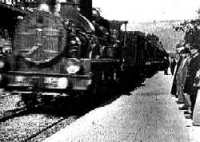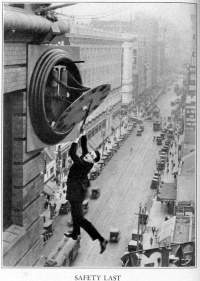Silent film
From The Art and Popular Culture Encyclopedia
| Revision as of 11:37, 18 August 2010 Jahsonic (Talk | contribs) ← Previous diff |
Current revision Jahsonic (Talk | contribs) |
||
| Line 1: | Line 1: | ||
| - | [[Image:Arrival of a Train at La Ciotat, 1895.jpg|thumb|right|200px| | + | [[Image:Harold Lloyd clutching the hands of a large clock as he dangles from the outside of a skyscraper above moving traffic.jpg |thumb|left|200px| |
| - | '''''L'arrivée d'un train en gare de La Ciotat''''' ('''''The Arrival of a Train at La Ciotat Station''''' is an [[1895 in film|1895]] [[France|French]] [[Short subject|short]] [[black-and-white]] [[silent film|silent]] [[documentary film]] directed and produced by [[Auguste and Louis Lumière]]. It was first screened on [[December 28]] [[1895]] in [[Paris]], [[France]], and was shown to a paying audience [[January 6]] [[1896]].]] | + | [[Harold Lloyd clutching the hands of a large clock as he dangles from the outside of a skyscraper above moving traffic]]]] |
| + | [[Image:Arrival of a Train at La Ciotat, 1895.jpg|thumb|right|200px|This page '''''{{PAGENAME}}''''' is part of the [[film]] series.<br>Illustration: screen shot from ''[[L'Arrivée d'un train en gare de La Ciotat]]'']] | ||
| + | [[Image:Le Voyage dans la lune.jpg|200px|thumb|right|''[[A Trip to the Moon]]'' ([[1902]]) [[Georges Méliès]]]] | ||
| + | [[Image:The Big Swallow.jpg|thumb|right|200px|Extreme [[close-up]] from the movie "[[The Big Swallow]]" ([[1901]]), produced and directed by [[James Williamson]] (1855-1933)]] | ||
| + | [[Image:Great Train Robbery still, public domain film.jpg|thumb|right|200px| | ||
| + | [[Great Train Robbery]]]] | ||
| {{Template}} | {{Template}} | ||
| A '''silent film''' is a [[motion picture]] with no accompanying, synchronized recorded [[sound]], especially spoken [[dialogue]]. | A '''silent film''' is a [[motion picture]] with no accompanying, synchronized recorded [[sound]], especially spoken [[dialogue]]. | ||
| Line 10: | Line 15: | ||
| :''[[homages to silent cinema]]'' | :''[[homages to silent cinema]]'' | ||
| Several filmmakers have paid homage to the comedies of the silent era, including [[Jacques Tati]] with his ''[[Les Vacances de Monsieur Hulot]]'' (1953) and [[Mel Brooks]] with ''[[Silent Movie]]'' (1976). Taiwanese director [[Hou Hsiao-Hsien]]'s acclaimed drama ''[[Three Times]]'' (2005) is silent during its middle third, complete with intertitles; [[Stanley Tucci]]'s ''[[The Impostors]]'' has an opening silent sequence in the style of early silent comedies. Brazilian filmmaker Renato Falcão's ''Margarette's Feast'' (2003) is silent. Writer / Director Michael Pleckaitis puts his own twist on the genre with ''Silent'' (2007). While not silent, the ''[[Mr. Bean]]'' TV show and movies have used the title character's non-talkative nature to create a similar style of humor. | Several filmmakers have paid homage to the comedies of the silent era, including [[Jacques Tati]] with his ''[[Les Vacances de Monsieur Hulot]]'' (1953) and [[Mel Brooks]] with ''[[Silent Movie]]'' (1976). Taiwanese director [[Hou Hsiao-Hsien]]'s acclaimed drama ''[[Three Times]]'' (2005) is silent during its middle third, complete with intertitles; [[Stanley Tucci]]'s ''[[The Impostors]]'' has an opening silent sequence in the style of early silent comedies. Brazilian filmmaker Renato Falcão's ''Margarette's Feast'' (2003) is silent. Writer / Director Michael Pleckaitis puts his own twist on the genre with ''Silent'' (2007). While not silent, the ''[[Mr. Bean]]'' TV show and movies have used the title character's non-talkative nature to create a similar style of humor. | ||
| - | |||
| - | The 1999 German film ''[[Tuvalu (film)|Tuvalu]]'' is mostly silent; the small amount of dialog is an odd mix of European languages, increasing the film's universality. [[Guy Maddin]] won awards for his homage to Soviet era silent films with his short ''[[The Heart of the World]]'' after which he made a feature-length silent, ''[[Brand Upon the Brain!]]'' (2006), incorporating live [[Foley artist]]s, narration and orchestra at select showings. ''[[Shadow of the Vampire]]'' (2000) is a highly fictionalized depiction of the filming of [[Friedrich Wilhelm Murnau]]'s classic silent [[vampire]] movie ''[[Nosferatu, eine Symphonie des Grauens|Nosferatu]]'' (1922). [[Werner Herzog]] honored the same film in his own version, ''[[Nosferatu: Phantom der Nacht]]'' (1979). | ||
| - | |||
| - | Some films draw a direct contrast between the silent film era and the era of talkies. ''[[Sunset Boulevard (1950 film)|Sunset Boulevard]]'' shows the disconnect between the two eras in the character of [[Norma Desmond]], played by silent film star [[Gloria Swanson]], and ''[[Singin' in the Rain (film)|Singin' In The Rain]]'' deals with the period where the people of Hollywood had to face changing from making silents to talkies. [[Peter Bogdanovich]]'s affectionate 1976 film ''[[Nickelodeon (film)|Nickelodeon]]'' deals with the turmoil of silent filmmaking in Hollywood during the early 1910s, leading up to the release of [[D.W. Griffith]]'s 1915 epic ''[[The Birth of a Nation]]''. | ||
| - | |||
| - | In 1999, the [[Finland|Finnish]] filmmaker [[Aki Kaurismäki]] produced ''Juha,'' which captures the style of a silent film, using intertitles in place of spoken dialogue. In India, the 1988 film ''[[Pushpak]]'', starring [[Kamal Hassan]], was a black comedy entirely devoid of dialog. The 2007 Australian film ''[[Dr Plonk]]'', was a silent comedy directed by Rolf de Heer. Stage plays have drawn upon silent film styles and sources. Actor/writers Billy Van Zandt & Jane Milmore staged their Off-Broadway slapstick comedy ''Silent Laughter'' as a live action tribute to the silent screen era. Geoff Sobelle and Trey Lyford created and starred in ''All Wear Bowlers'' (2004), which started as an homage to [[Laurel and Hardy]] then evolved to incorporate life-sized silent film sequences of Sobelle and Lyford who jump back and forth between live action and the silver screen. The 1940 animated film ''[[Fantasia (film)|Fantasia]]'', which is eight different animation sequences set to music, can be considered a silent film, with only one short scene involving dialogue. The 1952 espionage film ''[[The Thief (1952 film)|The Thief]]'' has music and sound effects, but no dialogue. | ||
| - | |||
| - | In 2005, the [[HPLHS|H.P. Lovecraft Historical Society]] made a [[The Call of Cthulhu (film)|silent film version]] of Lovecraft's story ''The Call of Cthulhu.'' This film maintained a period-accurate filming style, and was received as both "the best HPL adaptation to date" and, referring to the decision to make it as a silent movie, "a brilliant conceit." | ||
| ==See also== | ==See also== | ||
Current revision

Illustration: screen shot from L'Arrivée d'un train en gare de La Ciotat

|
Related e |
|
Featured: |
A silent film is a motion picture with no accompanying, synchronized recorded sound, especially spoken dialogue.
The idea of combining motion pictures with recorded sound is nearly as old as the motion picture itself, but because of the technical challenges involved, most films were silent before the late 1920s.
In reality, 'silent films' were almost never silent, but always accompanied by some kind of music, mostly live accompaniment by live piano. For example the very young Dmitri Shostakovich helped to make ends meet by playing the piano in a movie house and later went on to compose film scores for many silent films, including his debut The New Babylon.
Later homages
Several filmmakers have paid homage to the comedies of the silent era, including Jacques Tati with his Les Vacances de Monsieur Hulot (1953) and Mel Brooks with Silent Movie (1976). Taiwanese director Hou Hsiao-Hsien's acclaimed drama Three Times (2005) is silent during its middle third, complete with intertitles; Stanley Tucci's The Impostors has an opening silent sequence in the style of early silent comedies. Brazilian filmmaker Renato Falcão's Margarette's Feast (2003) is silent. Writer / Director Michael Pleckaitis puts his own twist on the genre with Silent (2007). While not silent, the Mr. Bean TV show and movies have used the title character's non-talkative nature to create a similar style of humor.
See also
- Ménilmontant (film), a 1926 silent film by Dimitri Kirsanoff
- Dr. Pyckle and Mr. Pryde
- Early horror films
- Laurel and Hardy
- German Expressionism
- Kammerspiel
- Lost films
- Sound film




